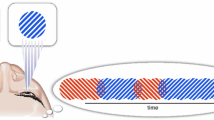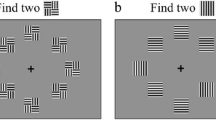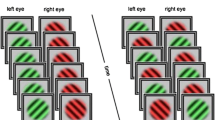Abstract
Among psychologists and vision scientists,binocular rivalry has enjoyed sustainedinterest for decades dating back to the 19thcentury. In recent years, however, rivalry'saudience has expanded to includeneuroscientists who envision rivalry as a “tool” for exploring the neural concomitants ofconscious visual awareness and perceptualorganization. For rivalry's potential to berealized, workers using this “tool” need toknow details of this fascinating phenomenon,and providing those details is the purpose ofthis article. After placing rivalry in ahistorical context, I summarize major findingsconcerning the spatial characteristics and thetemporal dynamics of rivalry, discuss two majortheoretical accounts of rivalry (“eye” vs“stimulus” rivalry) and speculate on possibleneural concomitants of binocular rivalry.
Similar content being viewed by others
References
Abadi, R., 1976: Induction masking-a study of some inhibitory interactions during dichoptic viewing, Vision Res. 16, 269-275.
Alais, D. andBlake, R., 1998: Interactions between global motion and local binocular rivalry, Vision Res. 38, 637-644.
Alais, D. andBlake, R., 1999: Grouping visual features during binocular rivalry, Vision Res. 39, 4341-4353.
Alais, D.,O'shea, R.P.,Mesana-Alais, C. and Wilson, I.G., 2000: Translation of Diaz-Caneja (1928) [On line]. Available: http://psy.otago.ac.nz:800/r_oshea/br_DJtrans.html
Amira, L., 1989: When are two eyes not better than one? Perception 18, 540 (abstr.).
Anderson, J.D.,Bechtoldt, H.P. andGregory, L.D., 1978: Binocular integration in line rivalry, Bull. Psychon. Soc. 11, 399-402.
Andrews, T.J. andBlakemore, C., 1999: Form and motion have independent access to consciousness, Nature Neurosci. 2, 405-406.
Andrew, T.J. andPurves, D., 1997: Similarities in normal and binocular rivalrous viewing, Proc. Natl. Acad. Sci. USA 94, 9905-9908.
Anstis, S. andRamachandran, V.S., 1987: Visual inertia in apparent motion, Vision Res. 27, 755-764.
Asher, H., 1953: Suppression theory of binocular vision, Brit. J. Ophthalmol. 37, 37-49.
Barany, E.H. andHallden, V., 1948: Phasic inhibition of the light reflex of the pupil during retinal rivalry, J. Neurophysiol. 11, 25-30.
Blake, R., 1988: Dichoptic reading: The role of meaning on binocular rivalry, Percept. Psychophys. 44, 133-141.
Blake, R., 1989: A neural theory of binocular rivalry, Psychol. Rev. 96, 145-167.
Blake, R., 1995: Psychoanatomical strategies for studying human vision, in T. Papathomas,C. Chubb,E. Kowler andA. Gorea (eds), Early Vision and Beyond, MIT Press, Cambridge.
Blake, R., 1997: What can be perceived in the absence of visual awareness? Current Directions in Psychol. Sci. 6, 157-162.
Blake, R. andFox, R., 1974a: Binocular rivalry suppression: Insensitive to spatial frequency and orientation change, Vision Res. 14, 687-692.
Blake, R. andFox, R., 1974: Adaptation to “invisible” gratings and the site of binocular rivalry suppression, Nature 249, 488-490.
Blake, R. andBoothroyd, K. 1985: The precedence of binocular fusion over binocular rivalry, Percept. Psychophys. 37, 114-124.
Blake, R. andBravo, M., 1985: Binocular rivalry suppression interferes with phase adaptation, Percept. Psychophys. 38, 277-280.
Blake, R.,Fox, R. andMcIntyre, C., 1971: Stochastic properties of stabilized-image binocular rivalry alternations, J. Exp. Psychol. 88, 327-332.
Blake, R.,Fox, R. andWestendorf, D., 1974: Visual size constancy occurs after binocular rivalry, Vision Res. 14, 585-586.
Blake, R.,Westendorf, D. andOverton, R., 1979: What is suppressed during binocular rivalry? Perception 9, 223-231.
Blake, R.,Zimba, L. andWilliams, D., 1985: Binocular correspondence and visual motion, Biol. Cybern. 52, 391-397.
Blake, R.,Westendorf, D. andFox, R., 1990: Temporal perturbations of binocular rivalry, Percept. Psychophys. 48, 593-602.
Blake, R.,Westendorf, D.H. andYang, Y., 1991: Discriminating binocular fusion from false fusion, Invest. Ophthalmol. Vis. Sci. 32, 2821-2825.
Blake, R.,O'shea, R.P. andMueller, T.J., 1992: Spatial zones of binocular rivalry in central and peripheral vision, Visual Neurosci. 8, 469-478.
Blake, R.,Yu, K.,Lokey, M. AndNorman, H., 1998: Binocular rivalry and visual motion, J. Cogn. Neurosci. 10, 46-60.
Blake, R.,Ahlstrom, U. andAlais, D., 1999: Perceptual priming by invisible motion, Psychol. Sci. 10, 145-150.
Blakemore, C.,Iverson, S.D. andZangwill, O.L., 1972: Brain functions, Ann. Rev. Psychol. 23, 413-456.
Bosking, W.H.,Zhang, Y.,Schofield, B. andFitzpatrick, D., 1997: Orientation selectivity and the arrangement of horizontal connections in tree shrew striate cortex, J. Neurosci. 17, 2112-2127.
Bossink, C.J.H., Stalmeier, P.F.M. and deWeert, C.M.M., 1993: A test of Levelt's second proposition for binocular rivalry, Vision Res. 33, 1413-1419.
Breese, B.B., 1899: On inhibition, Psychol. Monogr. 3, 1-65.
Breese, B.B., 1909: Binocular rivalry, Psychol, Rev. 16, 410-415.
Brenner, R.L.,Charles, S.T. andFlynn, J.T., 1969: Pupillary responses in rivalry and amblyopia, Arch. Ophthal. 82, 23-29.
Brown, K.T., 1955: Rate of apparent change in a dynamic ambiguous figure as a function of observation time, Amer. J. Psychol. 68, 358-371.
Campbell, F.W. andHowell, E. R., 1972: Monocular alternation; a method for the investigation of pattern vision, J. Physiol. 225, 19-21P.
Carlson, T.A. andHe, S., 2000: Visible binocular beats from invisible monocular stimuli during binocular rivalry, Current Biol. 10, 1055-1058.
Carney, T.,Shadlen, M. andSwitkes, E., 1987: Parallel processing of motion and colour information, Nature 328, 647-649.
Cave, C.,Blake, R. andMcNamara, T., 1998: Binocular rivalry disrupts visual priming, Psychol. Sci. 9, 299-302.
Collins, J.F. andBlackwell L.K., 1974: Effects of eye dominance and retinal distance on binocular rivalry, Percept. Mot. Skills 39, 747-754.
Creed, R.S., 1935: Observations on binocular fusion and rivalry, J. Physiol. 84, 381-392.
Das, A. andGilbert, C. D., 1995: Long-range horizontal connections and their role in cortical reorganization revealed by optical recording of cat primary visual cortex, Nature 375, 780-784.
Diaz-Caneja, E., 1928: Sur l'alternance binoculaire, Ann. Oculist, October, 721-731.
Dörrenhaus, W., 1975: Musterspezifischer visueller wettstreit, Naturwissenschaften 62, 578-579.
Engel, E., 1956: The role of content in binocular resolution, Amer. J. Psychol. 69, 87-91.
Engel, A.A.K.,Fries, P.,Konig, P.,Brecht, M. andSinger, W., 1999: Temporal binding, binocular rivalry and consciousness, Consciousness Cogn. 8, 128-151.
Fahle, M., 1982: Cooperation between different spatial frequencies in binocular rivalry, Biol. Cybern. 44, 27-29.
Fahle, M., 1987: Naso-temporal asymmetry of binocular inhibition, Invest. Ophthalmol. Vis. Sci. 28, 1016-1017.
Field, D.J.,Hayes, A. andHess, R.F., 1993: Contour integrations by the human visual system: evidence for a local “association” field, Vision Res. 33, 173-193.
Fox, R., 1991: Binocular rivalry, in D.M. Regan (ed.), Binocular Vision and Psychophysics. MacMillan Press, London, pp. 93-110.
Fox, R. andHerrmann, J., 1967: Stochastic properties of binocular rivalry alternations, Percept. Psychophys. 2, 432-436.
Fox, R. andCheck, R., 1968: Detection of motion during binocular rivalry suppression, J. Exp. Psychol. 78, 388-395.
Fox, R. andRasche, F., 1969: Binocular rivalry and reciprocal inhibition, Percept. Psychophys. 5, 215-217.
Fox, R. andCheck, R., 1972: Independence between binocular rivalry suppression and duration and magnitude of suppression, J. Exp. Psychol. 93, 283-289.
Fukuda, H., 1981: Magnitude of suppression of binocular rivalry within the invisible pattern, Percept. Mot. Skills 53, 371-375.
Fukuda, H. andBlake, R., 1992: Spatial interactions in binocular rivalry, J. Exp. Psychol. Hum. Percept. Perf. 18, 362-370.
Gibson, J.J., 1966: The Senses Considered as Perceptual Systems. Houghton-Mifflin, Boston.
Goryo, K., 1969: The effect of past experience upon the binocular rivalry, Jap. Psychol. Res. 11, 46-53.
Grindley, G.C. andTownsend, V., 1965: Binocular masking induced by a moving object, Q. J. Exp. Psychol. 17, 97-109.
Harrad, R.A.,McKee, S.P.,Blake, R. andYang, Y., 1994: Binocular rivalry disrupts Stereopsis, Perception 23, 15-28.
Helmholtz, H. von., 1925: In J.P. Southall (ed.), Treatise on Physiological Optics, Dover, New York.
Hochberg, J., 1964: Depth perception loss with local monocular suppression: a problem in the explanation of stereopsis, Science 145, 1334-1335.
Hollins, M., 1980: The effect of contrast on the completeness of binocular rivalry suppression, Percept. Psychophys. 27, 550-556.
Hollins, M. andLeung E.H.L., 1978: The influence of color on binocular rivalry, in J.C. Armington,J. Krauskopf andB.R. Wooten (eds.), Visual Psychophysics and Physiology, Academic Press, New York, pp. 181-190.
Hollins, M.And Hudnell, K., 1980: Adaptation of the binocular rivalry mechanism, Invest. Ophthalmol. Vis. Sci., 19, 1117-1120.
Holopigian, K., 1989: Clinical suppression and binocular rivalry suppression: the effects of stimulus strength on the depth of suppression, Vision Res. 29, 1325-1334.
Howard, I.P. andRogers, B.J., 1995: Binocular Vision and Stereopsis, Oxford University Press, New York.
Ichihara, S. andGoryo, K., 1978: The effects of relative orientation of surrounding gratings on binocular rivalry and apparent brightness of central gratings, Jap. Psychol. Res. 20, 159-166.
Jalavisto, E., 1964: The phenomenon of retinal rivalry in the aged, Gerontologia 9, 1-8.
Julesz, B. andMiller, J.E., 1975: Independent spatial-frequency-tuned channels in binocular fusion and rivalry, Perception 4, 125-143.
Julesz, B. andTyler, C.W., 1976: Neurontropy, an entropy-like measure of neural correlation in binocular fusion and rivalry, Biol. Cybern. 23, 25-32.
Kakizaki, S., 1960: Binocular rivalry and stimulus intensity, Jap. Psychol. Res. 2, 94-105.
Kaufman, L., 1963: On the spread of suppression and binocular rivalry, Vision Res. 3, 401-415.
Kovács, I.,Papathomas, T.V.,Yang, M. andFehér, A., 1997: When the brain changes its mind, Interocular grouping during binocular rivalry, Proc. Natl. Acad. Sci. USA 93, 15508-15511.
Kulikowski, J.J., 1992: Binocular chromatic rivalry and single vision, Ophthal. Physiol. Optics 12, 168-170.
Lack, L., 1969: The effect of practice on binocular rivalry control, Percept. Psychophys. 6, 397-400.
Lack, L., 1978: Selective Attention and the Control of Binocular Rivalry. Mouton, The Hague.
Lee, S.H. andBlake, R. 1999: Rival ideas about binocular rivalry, Vision Res. 39, 1447-1454.
Lehky S.R., 1988: An astable multivibrator model of binocular rivalry, Perception 17, 215-228.
Lehky, S.R., 1995: Binocular rivalry is not chaotic, Proc. R. Soc. Lond. B, 259, 71-76.
Lehmkuhle, S. andFox, R., 1976: Effect of binocular rivalry suppression on the motion aftereffect, Vision Res. 15, 855-859.
Leopold, D. andLogothetis, N., 1996: Activity changes in early visual cortex reflect monkeys' percepts during binocular rivalry, Nature 379, 549-553.
Levelt, W., 1965: On Binocular Rivalry, Soesterberg, the Netherlands, Institute for Perception RVOTNO.
Liu, L.,Tyler, C.W. andSchor, C.M., 1992: Failure of rivalry at low contrast: evidence of a suprathreshold binocular summation process, Vision Res. 32, 1471-1479.
Livingstone, M.S. andHubel, D.H., 1987: Psychophysical evidence for separate channels for the perception of form, color, movement, and depth, J. Neurosci. 7, 3416-3468.
Logothetis, N.K., 1998: Single units and conscious vision, Phil. Trans. R. Soc. Lond. B 353, 1801-1818.
Logothetis, N.K., 1999: Vision: a window on consciousness, Scientific Amer. 281, 68-75.
Logothetis, N.K. andSchall, J.D., 1989: Neuronal correlates of subjective visual perception, Science 245, 761-763.
Logothetis, N.K.,Leopold, D.A. andSheinberg, D.L., 1996: What is rivalling during binocular rivalry? Nature 380, 621-624.
Lorber, M.,Zuber, B.L. andStark, L., 1965: Suppression of the pupillary light reflex in binocular rivalry and saccadic suppression, Nature 208, 558-560.
LoSciuto, L.A. andHartley, E.L., 1963: Religious affiliation and open-mindedness in binocular resolution, Percept. Mot. Skills 17, 427-430.
Lumer, E.D.,Friston, K. andRees, G., 1998: Neural correlates of perceptual rivalry in the human brain, Science 280, 1930-1934.
Mapperson, B. andLovegrove, W., 1991: Orientation and spatial-frequency-specific surround effects on binocular rivalry, Bull. Psychon. Soc. 29, 95-97.
Mayhew, J.E.W. andFrisby, J.P., 1976: Rivalrous texture stereograms, Nature 264, 53-56.
Meenes, M., 1930: A phenomenological description of retinal rivalry, Amer. J. Psychol. 42, 260-269.
Mueller, T.J., 1990: A physiological model of binocular rivalry, Visual Neurosci. 4, 63-73.
Mueller, T.J. andBlake, R., 1989: A fresh look at the temporal dynamics of binocular rivalry, Biol. Cybern. 61, 223-232.
Myerson, J.,Miezin, F. andAllman, J., 1981: Binocular rivalry in macaque monkeys and humans: a comparative study in perception, Behav. Anal. Letters 1, 149-159.
Neisser, U. andBecklen, R., 1975: Selective looking: attending to visually specified events, Cogn. Psychol. 7, 480-494.
Ogle, K.N.andWakefield, J.M., 1967: Stereoscopic depth and binocular rivalry, Vision Res. 7, 89-98.
Ono, H.,Angus, R. andGregor, P., 1977: Binocular single vision achieved by fusion and suppression, Percept. Psychophys. 21, 513-521.
Ooi, T.L. andHe, Z.J., 1999: Binocular rivalry and visual awareness: the role of attention, Perception 28, 551-574.
O'shea, R.P., 1987: Chronometric analysis supports fusion rather than suppression theory of binocular vision, Vision Res. 27, 781-791.
O'shea, R.P. andCrassini, B., 1981: Interocular transfer of the motion aftereffect is not reduced by binocular rivalry, Vision Res. 21, 801-804.
O'shea, R.P. andCrassini, B., 1981: The sensitivity of binocular rivalry suppression to changes in orientation assessed by reaction-time and forced-choice techniques, Perception 10, 283-293.
O'shea, R.P. andCrassini, B., 1984: Binocular rivalry occurs without simultaneous presentation of rival stimuli, Percept. Psychophys. 36, 266-276.
O'shea, R.P. and Blake, R., 1986: Dichoptic temporal frequency differences do not lead to binocular rivalry, Percept. Psychophys. 39, 59-63.
O'shea, R.P. andWilliams, D.R., 1996: Binocular rivalry with isoluminant stimuli visible only via short-wavelength-sensitive cones, Vision Res. 36, 1561-1571.
O'shea, R.P.,Blake, R. andWolfe, J.M., 1994: Binocular rivalry and fusion under scotopic luminances, Perception 23, 771-784.
O'shea, R.P.,Sims, A.J.H. andGovan, D.G., 1997: The effect of spatial frequency and field size on the spread of exclusive visibility in binocular rivalry, Vision Res. 37, 175-183.
Palmer, S.E., 1999: Vision Science: Photons to Phenomenology, M.I.T. Press, Cambridge, MA.
Papathomas, T.V.,Kovács, I.I.,Fehér, A. andJulesz, B., 1999: Visual dilemmas: competition between eyes and between percepts in binocular rivalry, in E. Lepore andZ. Pylyshyn (eds), What is Vognitive Science? Blackwell Publishers, Malden, MA, pp. 263-294.
Polansky, A.,Blake, R.,Braun, J. andHeeger, D., 2000: Neuronal activity in human primary visual cortex correlates with perception during binocular rivalry, Nature Neurosci. 3, 1153-1159.
Porta, J.B., 1593: De Refractione. Optices Parte. Libri Novem. Carlinum and Pacem, Naples (cited in Wade, 1998).
Ramachandran, V.S., 1991: Form, motion, and binocular rivalry, Science 251, 950-951.
Sheinberg, D.L. andLogothetis, N.K., 1997: The role of temporal cortical areas in perceptual organization, Proc. Natl. Acad. Sci. USA 94, 3408-3413.
Sherrington, C.S., 1906: Integrative Action of the Nervous System, Yale University Press, New Haven.
Shimojo, S. andNakayama, K., 1990: Real world occlusion constraints and binocular rivalry, Vision Res 30, 69-80.
Smith, E.L.,Levi, D.M.,Harwerth, R.S. andWhite, J.M., 1982: Color vision is altered during the suppression phase of binocular rivalry, Science 218, 802-804.
Srinivasan, R.,Russell, D.P.,Edelman, G. M. andTononi, G., 1999: Increased synchronization of neuromagnetic responses during conscious perception, J. Neurosci. 19, 5435-5448.
Struber, D. andStadler, M., 1999: Differences in top-down influences on the reversal rate of different categories of reversible figures, Perception 28, 1185-1196.
Sugie, N., 1982: Neural models of brightness perception and retinal rivalry in binocular vision, Biol. Cybern. 43, 13-21.
Thompson, R.F., 1985 The Brain, W.H. Freeman and Company, New York.
Tong, F.,Nakayama, K.,Vaughan, J.T. andKanwisher, N., 1998: Binocular rivalry and visual awareness in human extrastriate cortex, Neuron 21, 753-759.
Tononi, G.,Srinivvasan, R.,Russell, D.P. andEdelman, G.M., 1998: Investigating neural correlates of conscious perception by frequency-tagged neuromagnetic responses, Proc. Natl. Acad. Sci. USA 95, 3198-3203.
Tootell, R.B.H.,Reppas, J.B.,Dale, A.M.,Look, R.B.,Sereno, M.I.,Malach, R.,Brady, T.J. andRosen, B.R., 1995: Visual motion aftereffect in human cortical area MT revealed by magnetic resonance imagery. Nature 375, 139-141.
Treisman, A.M., 1962: Binocular rivalry and stereoscopic depth perception, Quart. J. Exp. Psychol. 14, 23-37.
Treisman, A. andSchmidt, H., 1982: Illusory conjunctions in the perception of objects, Cogn. Psychol. 14, 107-141.
van de Grind, A., van Hof, P., van der Smagt, M.J. and Verstraten, A.J., in press: Slow and fast visual motion channels have independent binocular rivalry stages, Proc. Roy. Soc., Biol. Sci.
van der Zwan, R. andWenderoth, P., 1994: Psychophysical evidence for area V2 involvement in the reduction of subjective contour tilt aftereffects by binocular rivalry, Visual Neurosci. 11, 823-830.
van der Zwan, R.,Wenderoth, P. andAlais, D., 1993: Reduction of a pattern-induced motion aftereffect by binocular rivalry suggests the involvement of extrastriate mechanisms, Visual Neurosci. 10, 703-709.
Wade, N.J., 1974: The effect of orientation in binocular contour rivalry of real images and afterimages, Percept. Psychophys. 15, 227-232.
Wade, N.J., 1975: Binocular rivalry between single lines viewed as real images and afterimages, Percept. Psychophys. 17, 571-577.
Wade, N.J., 1998: A Natural History of Vision, MIT Press, Cambridge MA.
Wade, N.J. andWenderoth, P., 1978: The influence of colour and contour rivalry on the magnitude of the tilt after-effect, Vision Res. 18, 827-836.
Wade, N.J.,de Weert, C.M. M. andSwanston, M.T., 1984: Binocular rivalry with moving patterns, Percept. Psychophys. 35, 111-122.
Wales, R. andFox, R. 1970: Increment detection thresholds during binocular rivalry suppression, Percept. Psychophys. 8, 90-94.
Walker, P., 1975: The subliminal perception of movement and the “suppression” in binocular rivalry, Br. J. Psychol. 66, 347-356.
Walker, P., 1978: Binocular rivalry: central or peripheral selective processes? Psychol. Bull. 85, 376-389.
Walker, P. andPowell, D.J., 1979: The sensitivity of binocular rivalry to changes in the nondominant stimulus, Vision Res. 19, 247-249.
Wiesenfelder, H. andBlake, R., 1990: The neural site of binocular rivalry relative to the analysis of motion in the human visual system, J. Neurosci. 10, 3880-3888.
Wiesenfelder, H. andBlake, R., 1991: Apparent motion can survive binocular rivalry suppression, Vision Res. 31, 1589-1600.
Wheatstone, C., 1838: On some remarkable, and hitherto unobserved, phenomena of binocular vision. Phil. Trans. R. Soc. Lond. 128, 371-394.
Whittle, P., 1965: Binocular rivalry and the contrast at contours, Q. J. Exp. Psychol. 17, 217-226.
Whittle, P.,Bloor, D. andPocock, S. 1968: Some experiments on figural effects in binocular rivalry, Percept. Psychophys. 4, 183-188.
Wolfe, J., 1983: Influence of spatial frequency, luminance, and duration on binocular rivalry and abnormal fusion of briefly presented dichoptic stimuli, Perception 12, 447-456.
Wolfe, J., 1986: Stereopsis and binocular rivalry, Psychol. Rev. 93, 269-282.
Wolfe, J. andFranzel, S.L., 1988: Binocularity and visual search, Percept. Psychophys. 44, 81-93.
Yang, Y.,Rose, D. andBlake, R., 1992: On the variety of percepts associated with dichoptic viewing of dissimilar monocular stimuli, Perception 21, 47-62.
Yu, K. andBlake, R., 1992: Do recognizable figures enjoy an advantage in binocular rivalry? J. Exp. Psychol. Hum. Percept. Perf. 18, 1158-1173.
Zimba, L. andBlake, R., 1983: Binocular rivalry and semantic processing: Out of sight, out of mind, J. Exp. Psychol. Hum. Percept. Perf. 9, 807-815.
Author information
Authors and Affiliations
Rights and permissions
About this article
Cite this article
Blake, R. A Primer on Binocular Rivalry, Including Current Controversies. Brain and Mind 2, 5–38 (2001). https://doi.org/10.1023/A:1017925416289
Issue Date:
DOI: https://doi.org/10.1023/A:1017925416289




